|
One nice thing about having
a website like Airplanes and Rockets is that every once in a while a famous person
will contact me with some great information. It happened again recently when David
J. Holland wrote about how he still has the original artwork of his "Flying Men"
models from the cover of the 1962 Annual Edition of American Modeler. He
sent a photo of the magazine cover next to the framed original, along with a photo
of his actual control line model.
Says Dave, "The picture is of a magazine cover and article about my funny face
models in the '50s and early 1960s. The model pictured is the third version as I
wore out the first two. The story and cover were the result of a demonstration flight
I did during the Sunday air show at the 1961 Nationals at the Willow Grove, PA,
naval air station. I have the original art work of the cover, four times the size
of the magazine."
Dave's story prompted me to obtain a copy of the 1962 American Modeler
Annual Edition in order to have the original article that went along with it. It
is now part of my
magazine collection that is available for article copy requests.
David J. Holland's "Flying Men" Cover Art Model
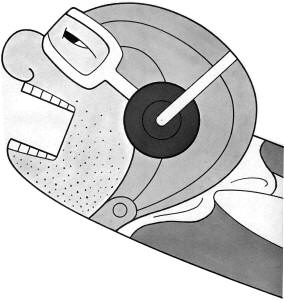 Where do these awesome creatures come from?
Cal Smith sez that only Dave [J.] Holland knows! Where do these awesome creatures come from?
Cal Smith sez that only Dave [J.] Holland knows!
It's a bird!-It's a plane! - No, it's the Flying Man!
Take one Sterling Ringmaster kit, add a liberal helping of ingenuity, a real
kookie paint job, mix well and behold-the Flying Man. This is the formula developed
by Dave Holland of Elyria, Ohio, in creating his series of Flying Man models. American
Modeler readers will recall Dave's "Skydiver" "Uncle Sam" and "Dennis-the-Menace"
(Dec. 1959, April 1960, May 1961 issues). There is also a "Yogi Bear" now flying
around Ohio.
These Flying Man models are different, make no mistake, Not only do the novel
paint jobs set these models apart from the average stunt ship, they are also capable
of some unusual flight performance.
With a K&B Torpedo 29 turning a 9D-6P Nylon prop the models can do the Saber
Dance, hanging vertical and virtually motionless on the end of the flying lines,
without benefit of engine throttle control. Dave advises that in a single flight
his crates can make VTO's and landings. They can hang on their prop anywhere from
one inch to thirty-five foot altitude. They will perform like a helicopter, flying
slowly around the circle in a vertical position. The jobs will also do most of the
stunt pattern. Dave reports he can play tag with his son Randy. Randy also assists
in making hand-held VTO's and pick-it-out-of-the-air retrieves at the end of flights.
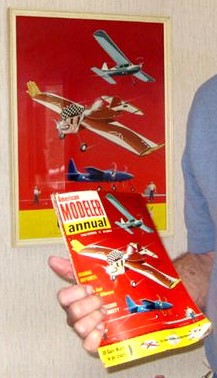
Dave's original cover art along with the cover of the 1962 Annual
Edition of American Modeler
The Skydiver Flying Man has been flown for over four years, logged over 1000
flights, used up thirty gallons of fuel. Landing gear and control system were replaced
along the way after the original equipment wore out. But the original Torp 29 is
still in use. Skydiver has won eight trophies and mucho merchandise in balloon-breaking
contests.
The Ringmaster is the basic part of each Flying Man shown here. Only a few changes
are needed to modify the kit into these unique designs. First, the outline on the
kit fuselage top should be carved off to make a smooth top profile. A new plywood
doubler is added to make the face outline and a plywood fin is substituted for the
balsa kit part. The stabilizer mounts in a slot in the fuselage tail level with
the wing on the thrust line instead of on top of fuselage plank. A one ounce weight
is added to the outer wingtip. The cutout for the engine is filled in to shorten
the opening; 3/8" x 1/2" hardwood engine bearers are let into the fuselage plank
between the plywood doublers. Nylon covering is used for durability and added strength.
The Torp 29 is mounted with up to 15° off-set towards the outside of circle to help
maintain tension on the flying wires. A 9D-6P Nylon prop is used and a 4-oz Perfect
fuel tank is fitted. Landing gear can be stiffened by adding another vee from legs
to engine mount area.
The control system linkage should be set up so that greater than normal elevator
travel is obtained. Elevator should move at least 70° both up and down (total 140°)
to give the greater control needed for the extreme attitude changes of the model
during flight.
The only tricky part of the conversion is the doubler construction for the face
at the nose. One regular kit doubler is installed on one side of the nose, the other
side requires a new doubler. This is made of 3/32" birch plywood cut to both the
outline of the nose section along the bottom and the full face and head outline.
It is also made 1-1/2" longer than the kit doubler for added strength. The head
space above the fuselage is filled with %" balsa sheet to the same profile as the
new doubler.
This construction detail and other pertinent data is shown on the "Uncle Sam"
plan. This also applies to the other designs.
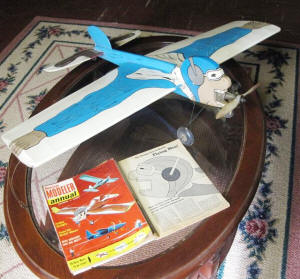
Dave's modified Sterling Ringmaster
The original "Uncle Sam" and "Skydiver" were rigged for clockwise flight to take
advantage of torque as an aid to maintaining line tension. Since most stunt models
are rigged just the opposite (counter-clockwise flight) these designs can be so
rigged for flyers accustomed to the regular stunt flight direction. Randy Holland's
Dennis-the-Menace rigged in standard fashion performs well. Slightly more thrust
line offset may be needed.
To achieve smooth hovering flight the model's weight must be just offset by engine
thrust. The Ringmaster Torp 29 combination works very well, so don't try to change
things around. It is a good idea to leave fuselage plank the full 1/2" thick along
its entire length. Test fly the model after several coats of clear dope have been
applied, then if any shaving to reduce the weight is needed it can be done without
ruining a fancy paint job.
You don't have to be a Rembrandt to duplicate the paint schemes shown in the
drawings. Note that the various colors are coded and indicated on each drawing.
Always apply the lightest colors first, so that any overlap of darker colors will
cover easily. The "Uncle Sam" design will require the use of masking tape to achieve
the straight lines. Stars along the wing leading edge can be cut from fuel-proof
decal sheets and doped on. Face and hat detail can be painted on free-hand and will
require careful workmanship.
The hand-arm, scarf and coat detail on "Skydiver" and "Early Birdman" are best painted
on free-hand and if a few extra wiggles develop in the process this will only add
to the originality of your artistic efforts. The outlines of all detail can be accented
with a narrow black lines, in the best cartoon fashion. This will give the design
better visibility when viewed from a distance.
The "Early Birdman" (Oily Boidman) design shown on the cover offers a third possibility
carrying Dave Holland's idea a bit further. We substituted a real cloth scarf for
a painted-on one, and this makes the model self-wiping in flight. The real buttons
on the sleeves should be about 3/4" dia. cemented well to covering. The gloved hands
should have edges sanded to a half-round section (yes, there are only four fingers,
a la the cartoon characters).
Note that the cover drawing shows coat tails and ankles mounted along the fuselage
top. To simplify construction FOLLOW THE PLAN DRAWING... not the cover. With stabilizer
mounted level with the wing, the space between wing trailing edge and stab leading
edge is more easily filled with sheet balsa to make coat and ankle outline. The
paint job then simply extends over wing surface onto sheet fill-in, then on back
to stabilizer.
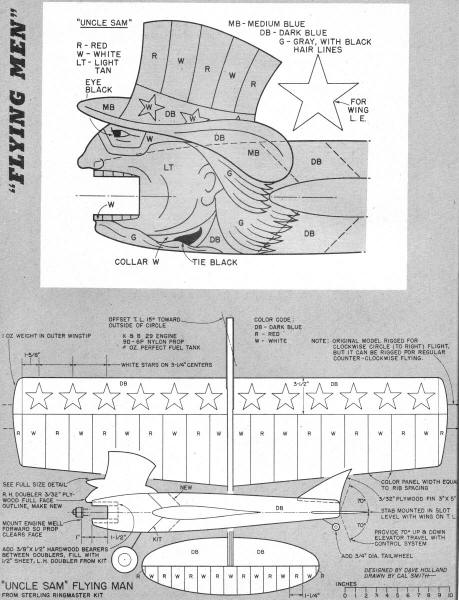
"Uncle Sam" Flying Man
<click for larger version>
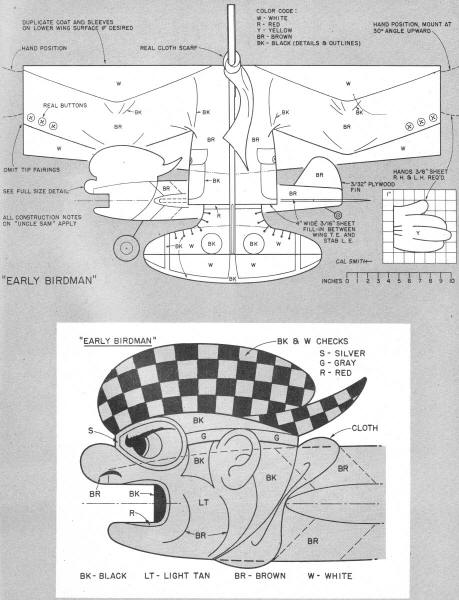
"Early Birdman" Flying Man
<click for larger version>
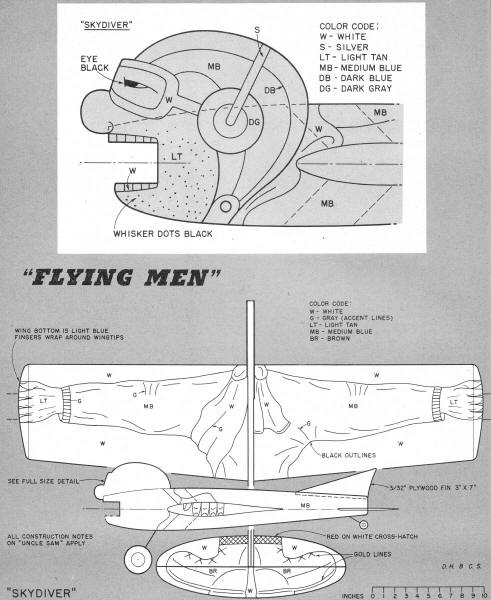
"Skydiver" Flying Man <click for larger version>
(Full size drawings of the heads are scheduled for Hobby Helpers' Group Plan
# AMA-620.)
Notice:
The AMA Plans Service offers a
full-size version of many of the plans show here at a very reasonable cost. They
will scale the plans any size for you. It is always best to buy printed plans because
my scanner versions often have distortions that can cause parts to fit poorly. Purchasing
plans also help to support the operation of the
Academy of Model Aeronautics - the #1
advocate for model aviation throughout the world. If the AMA no longer has this
plan on file, I will be glad to send you my higher resolution version.
Try my Scale Calculator for
Model Airplane Plans.
Posted May 17, 2021
(updated from original post on 1/1/2011)
|



